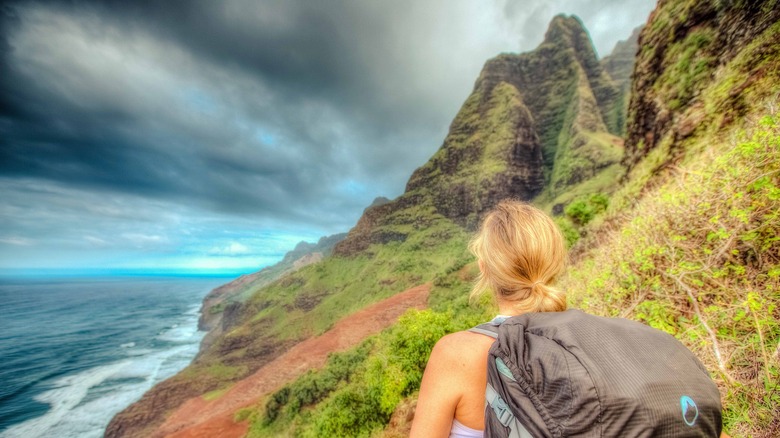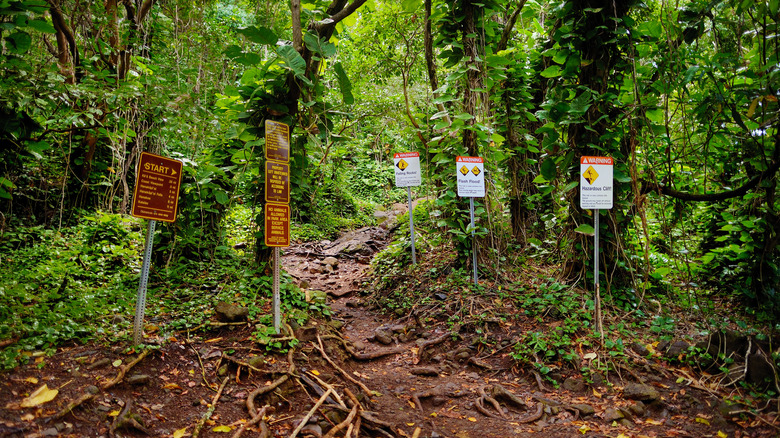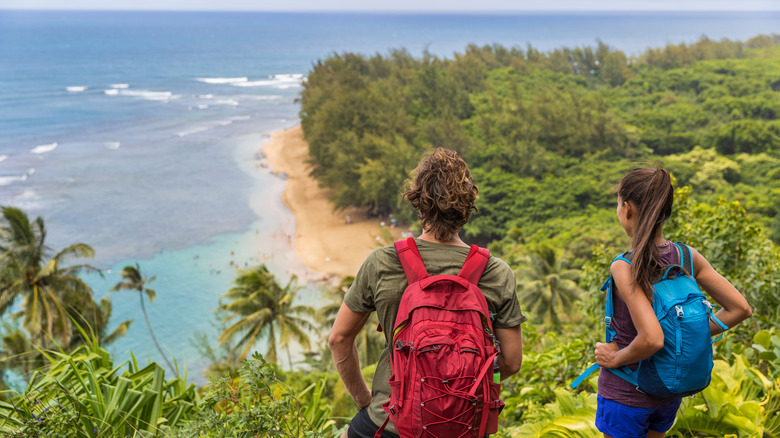Be Prepared For The Treacherous Beauty Of This Deadly Hawaii Trail
We may receive a commission on purchases made from links.
If you want to see Hawaii's famed Na Pali Coast on the island of Kauai from land, there are only a handful of ways to do it. One of the most popular is to hike the Kalalau Trail, which is one of the few land access points along this scenic stretch of shoreline. However, this rugged and popular trail, which dates back to the 1800s, doesn't just offer awe-inspiring views. There are also a number of unexpected hazards. So, while this trail is considered one of the most picturesque on the planet, it is also among the most dangerous places to hike in the world.
That is not to say you should not attempt to hike this historic trail, which today is managed by the Hawaii Department of Land and Natural Resources. However, it is important to be aware of the risks and potential dangers before embarking on an adventure along this out and back hike that covers a total of 22 miles. In fact, that distance is the first thing you should be aware of. Since it typically takes a full day for even experienced hikers to complete the round trip, they are not allowed to attempt the full length without obtaining an overnight camping permit.
Whether setting out to hike all or part of the trail, hikers should be well aware of the hazards that may be experienced along the Kalalau Trail. The trail's rugged terrain has resulted in dozens of injuries and deaths over the past decade alone. While some of these incidents were perhaps unavoidable, knowing the risks, as well as proper preparation, can help ensure a safe adventure along the Kalalau Trail.
Attractions and hazards abound on the Kalalau Trail
The Kalalau Trail has become famous (and infamous) because it is filled with both stunning natural attractions and dangerous hazards. The aforementioned length of the trail is chief among those. Whether attempting the entire distance or just the initial leg, which extends two miles from the trail head in Ha'ena State Park to Hanakapi'ai Beach, you need to make sure you are in adequate shape for the uneven terrain and constantly changing elevation. Exhaustion has led to a number of emergency rescues, including a 2024 incident where hiker had to be airlifted from the beach area, and an increase chance of falling on the uneven and often slippery terrain.
Even those who are in good physical condition will face potential hazards both on the trail and along the beachfront. Among the possible dangers listed in the D.L.N.R.'s Kalalau Trail brochure are falling rocks, flash flooding, cliffs that may collapse or give way, strong riptide currents, and dangerous shorebreak waves. To help address some of these hazards, pets and rock climbing are prohibited. Additionally, trail visitors are strongly encouraged to know the limits and not attempt to exceed them whether hiking or swimming.
Undoubtedly the reason visitors continue to flock to the Kalalau Trail despite these ominous dangers is to enjoy the spending scenery and activities the trail presents. Sheer cliffs, rising mountain peaks, spectacular ocean views, remote beaches, and a diverse array of flora and fauna can all be found along the trail's length. In addition to sightseeing and hiking, visitors can partake in swimming, body surfing, bow hunting, and camping.
Precautions you should take on the Kalalau Trail
In order to have a safe and enjoyable experience on the Kalalau Trail, there are a few precautions that you should take. For starters, be aware of your experience level. According to AllTrails, only experienced hikers should attempt the full length of the trail. Hikers of lesser experience, however, can tackle sections of the initial leg, but still should proceed with caution.
Proper preparation can also go a long way, not only for preventing accidents, but also for being able to respond to any incidents that do happen. Anyone who is looking to attempt the full length should preview the trail on AllTrails or a similar outdoor app. It is also important to obtain an overnight camping permit, which is required in order to hike the full trail. Additionally, anyone wanting to hike all or part of the trail needs to make advanced reservations at Ha'ena State Park in order to access the trail head.
Hikers should also be prepared with the 10 hiking essentials for emergencies, as they would on any trail. A gear pack, such as the Everlit Survival First Aid and Emergency Kit, can help address a number of emergency situations. It is also important to be able to navigate and communicate while on the trail. Given the remoteness of both the trail and the island of Kauai, it is a good idea to download safety and navigation apps ahead of time. Don't forget a communication device, such as the Garmin inReach Messenger, which will allow you to call for help even if you are without cell service.


